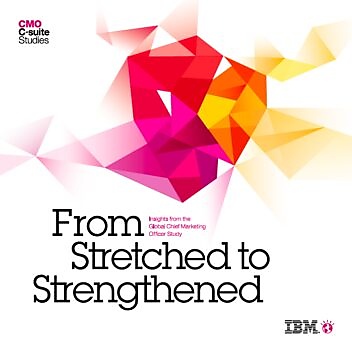It’s the closest thing you can get to “the state of the marketing union”, including new technology, social media, analytics and digital-driven change. Some highlights.
IBM interviewed 1,734 CMOs between February and June about their jobs. The feedback is, on the whole, unsurprising. But, amongst all the noise about what is important or significant to marketing today, this is a healthy reminder (or correction).
I suggest anyone who works in marketing to give it a read. You’ll find the full IBM CMO report here. I’ve pulled out some highlights:
The vast majority of CMOs believe there are three key areas for improvement. They must understand and deliver value to empowered customers; create lasting relationships with those customers; and measure marketing’s contribution to the business in relevant, quantifiable terms.
–
A full 79 percent of the CMOs we talked with believe the level of complexity will be high or very high over the next five years. But only 48 percent feel prepared to cope with it. A telecommunications CMO in Brazil described the prevailing view when she said: ‘The empowerment of the consumer is generating more complexity. The mental model is changing. We are facing a major social transformation.’
–
CMOs are stretched. Even those who work for the most successful organisations are struggling.
In our last CEO study, 88 percent of business leaders – and an astounding 95 percent of those heading the most successful organisations – said getting closer to their customers was the top priority for realising their strategy over the next five years.
–
One reason most organisations struggle to get the customer insights they need is that they still focus on understanding markets rather than individuals. At least 80 percent of CMOs rely on traditional sources of information such as market research and competitive benchmarking to make strategic decisions.
–
An industrial products CMO in the United States spoke for many when she said: ‘I don’t see how we can go forward without embedding IT into marketing.’
–
But the traditional marketing ‘funnel’ has now become a series of loops. Customers evaluate a shifting array of options. They consult (off- and online) peers, family members, independent experts and retailers or manufacturers, although the latter come last on the list.
–
The differences are particularly marked in the phases devoted to stimulating awareness and desire and building advocacy after the sale. As a telecommunications CMO in Belgium commented, ‘Marketing performance tracking is driven by customer loyalty. End-to-end (E2E) lifecycle management is key.’
–
CMOs are well aware they will have to be much more financially accountable in the future. In fact, 63 percent of respondents believe marketing ROI will become the most important measure of success over the next three to five years.
–
The increase in the percentage of CMOs planning to use outside agencies for lead management, customer and data analytics and direct or relationship marketing was especially pronounced. The percentage of CMOs planning to get help with IT, call or service centre management and tracking and measurement also rose by more than half.
–
Where should you begin? Create a small action team composed of eager marketing futurists – individuals within your organisation who have the potential to be CMOs themselves someday. Give these people a short timeframe to review the issues and develop recommendations for resolving them.

Enjoyed this article?
Take part in the discussion









Comments
There are no comments yet for this post. Why not be the first?